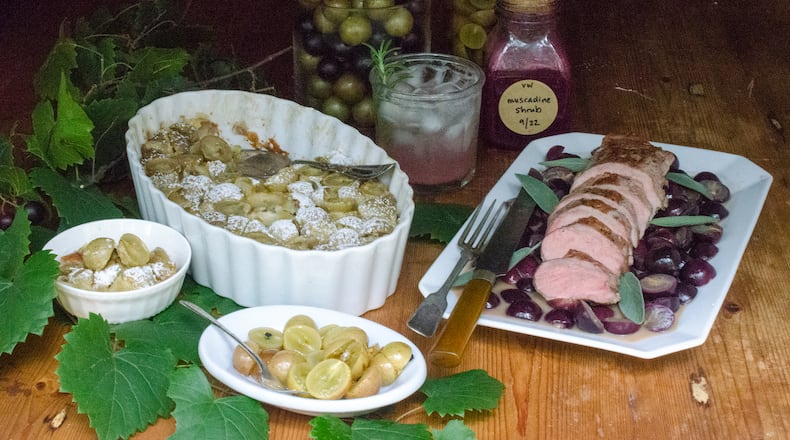Muscadines are an indigenous wild grape native to the Southeast. Typically, the gold green ones are referred to as scuppernongs, and the dark purple are known as muscadines. Scuppernongs are actually a variety of muscadines. Both grapes have a tough, thick skin that ranges in color from deep purple to greenish bronze.
Regardless of what you call them, these grapes are a taste of my childhood. The sweet, musky aroma takes me back to the hand-built wooden arbor at my grandparents’ home in Evans, Georgia. Thick, gnarled and twisted gray-brown trunks formed a large canopy instead of growing in a row like traditional grapes. In late summer through early fall, the thick foliage would be studded with small clusters of fruit.
My grandfather made muscadine wine in the cellar in oversized glass jars — for medicinal purposes, of course. His wine was cloudy, unfiltered, and quite sweet. Several years ago, we found a bottle in the back of the cabinet, at least 20 years old, that had aged and mellowed to an amber honey liqueur.
The grapes that made it upstairs into the kitchen were transformed into countless jars of jelly. Freshly harvested grapes were piled into gigantic pots and simmered, then strained and boiled with sugar. Scuppernongs make an excellent jelly, fruity and boldly flavored with tannins from the thick skin. I think I was in first grade when I had my first taste of store-bought jelly. It was the ubiquitous Concord grape jelly of childhood, and I remember not liking it. I had never had jelly before that wasn’t homemade — and very likely muscadine.
My grandparents’ arbors were prolific. As children, my sister and I would stand for hours using both of our hands and mechanically eating the fruit like locusts. We’d squeeze the fruit into our mouths and spit out the seeds and tough bitter skins. Once, I reached into the arbor to pick a greenish globe. Just as my fingers started to close on the fruit, it moved. My scuppernong was the head of a green snake. Scared out of my wits, I ran screaming into the house. My grandmother’s constant reminder about staying out of the bushes because of snakes had finally come true.
Scuppernongs (and snakes) thrive in the South, but grow as far north as Delaware and as far west as Texas. They are the state fruit of North Carolina, named after the Scuppernong River, which is located just off Albemarle Sound at the Outer Banks.
Given our muscadine-friendly climate, many Southerners are familiar with popping the succulent hard-hulled grapes and eating them out of hand. There’s a long history of using them in preserves or wine. A lesser-known dessert tradition is Hull Pie. Instead of throwing away the tough skins after a day of making muscadine grape jelly, thrifty cooks created a delicious pie filling. Muscadine grape hull pie was traditionally made with just the hulls of the grape to prevent food waste.
This collection of recipes goes beyond the traditional and shows the grape’s versatility. However, there is a nod at the past and muscadines’ penchant for preserving with Pickled Muscadines and Muscadine Shrub. Pork and Grapes are winemakers’ dinner all across Europe, and muscadines give the dish a bit more pop. Instead of the more traditional Hull Pie, made with sugar, flour and cream, the dessert recipe here is a take on a classic French sweetened custard known as clafoutis, and traditionally made with cherries.
Virginia Willis is an Atlanta-based Food Network Kitchen chef, James Beard Award-winning food writer and cookbook author. Follow her at virginiawillis.com.
RECIPES
Taste beyond the traditional with recipes for Pickled Muscadines, Muscadine Shrub, Pork Tenderloin with Muscadines, and Muscadine Clafoutis. Muscadines, often sold in 20-ounce containers, may be stored in the refrigerator for up to one week.
Credit: Virginia Willis
Credit: Virginia Willis
Pickled Muscadines
Seeding the grapes is a bit tedious, but worth it. The seeds are often quite large and there are two seeds per grape. The trick is to halve the grapes vertically with a paring knife, not horizontally. Then, use the tip of the knife to flick out the seeds. Serve these sweet-and-sour pickled grapes as part of a charcuterie or cheese board, or to accompany roast chicken or pork chops.
Credit: Virginia Willis
Credit: Virginia Willis
Muscadine Shrub
A shrub is a tart syrup made from fresh fruit, sugar and vinegar. Prior to refrigeration, shrubs were a way to preserve the fruit harvest. They make a great nonalcoholic beverage — and taste terrific as a mixer, too.
Credit: Virginia Willis
Credit: Virginia Willis
Pork Tenderloin with Muscadines
Pork’s affinity for fruit is well known. Although apples are certainly a go-to, any sweet fruit with a good burst of tartness is an excellent choice. Muscadines fit the bill with their sweet flesh and tart, tannic skins. As the grapes roast with the pork, they melt into softness, blending with the mustard and butter to create a velvety sauce.
Credit: Virginia Willis
Credit: Virginia Willis
Muscadine Clafoutis
Clafoutis is a batter pudding with origins in the Limousin region of France. This homestyle baked custard is traditionally made with cherries, but muscadines and scuppernongs substitute nicely.
Sign up for the AJC Food and Dining Newsletter
Read more stories like this by liking Atlanta Restaurant Scene on Facebook, following @ATLDiningNews on Twitter and @ajcdining on Instagram.
About the Author
The Latest
Featured






